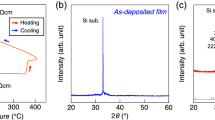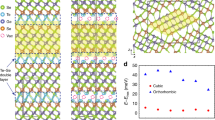Abstract
Phase change materials (PCMs) exhibit unique optical properties and have been widely used in various fields, such as optical memory, optical switches, and optical neuromorphic computing devices. However, owing to the lack of an evaluation criterion for assessing the optical performance of PCMs, the design of new PCMs mainly depends on empirical knowledge. Herein, a new evaluation criterion known as the material figure of merit (FOM2 = Δk/kamor) was introduced to assess the optical performance of PCMs in absorption-modulated integrated photonics. The FOM value represents the potential of PCMs in constructing high-performance PCM-based photonic devices. A higher FOM value indicates broader applicability of PCMs in photonic devices. To explore the relationships between the optical parameters of PCMs and the FOM value, three new optical PCMs based on Ge2Sb2Te5 (GST) were developed according to the theory of optical bandgap. The results indicate that doping with non-metallic elements, such as nitrogen, increases the FOM2 values of GST, which is beneficial for developing low-loss and high-modulation space absorption-modulated PCM-based photonic devices and large-scale absorption-modulated PCM-based photonic arrays. Additionally, the crystallization temperature of PCMs affects the programming power, endurance, and stability of the devices. Therefore, selecting suitable PCMs tailored to the specific requirements of the device in real-world applications is crucial. Our study provides an evaluation criterion for assessing the optical performance of PCMs, thereby facilitating the design of customized materials for photonic applications.

摘要
相变材料(PCM)具有优异的光学性质, 在多种集成光子器件中极 具应用前景, 如光存储器、光开关和光神经形态计算器件. 然而, 由于 集成光子器件相变材料光学性能评价标准的缺乏, 新型相变材料的设 计主要依赖于研究者的研究经验. 本文基于相变光子器件的性能需求, 引入材料品质因子(FOM2 = Δk/kamor)来评价相变材料的光学性能, 建 立了针对损耗调制型相变光子器件相变材料的光学性能评价标准. FOM值的大小代表相变材料在构建高性能相变光子器件中的应用潜 力, FOM值越大, 相变材料应用于光子器件的限制就越小. 在此基础上, 本文基于光学带隙理论, 建立了相变材料光学参数与FOM值之间的关 系, 开发了三种基于GST的新型光学相变材料. 结果表明, 氮等非金属 元素掺杂可以提高GST的FOM值, 有利于开发低损耗、高调制空间的 损耗型相变光子器件和大规模损耗型相变光子阵列. 除了FOM之外, 相变材料的结晶温度也会影响器件的编程功耗、循环寿命和稳定性, 这要求我们在实际应用场景中根据器件的需求选择合适的相变材料. 总之, 本文为相变材料的光学性能提供了评价标准, 促进了集成光子器 件应用中相变材料的定制设计.
Similar content being viewed by others
References
Fang Z, Chen R, Tara V, et al. Non-volatile phase-change materials for programmable photonics. Sci Bull, 2023, 68: 783–786
Edinger P, Takabayashi AY, Errando-Herranz C, et al. Silicon photonic microelectromechanical phase shifters for scalable programmable photonics. Opt Lett, 2021, 46: 5671–5674
Pérez D, Gasulla I, Capmany J. Programmable multifunctional integrated nanophotonics. Nanophotonics, 2018, 7: 1351–1371
Fang Z, Chen R, Zheng J, et al. Non-volatile reconfigurable silicon photonics based on phase-change materials. IEEE J Sel Top Quantum Electron, 2022, 28: 1–17
Stegmaier M, Ríos C, Bhaskaran H, et al. Nonvolatile all-optical 1 × 2 switch for chipscale photonic networks. Adv Opt Mater, 2017, 5: 1600346
Zhang H, Xu L, Chen J, et al. Ultracompact Si-GST hybrid waveguides for nonvolatile light wave manipulation. IEEE Photonics J, 2018, 10: 1–10
Yang X, Nisar MS, Yuan W, et al. Phase change material enabled 2 × 2 silicon nonvolatile optical switch. Opt Lett, 2021, 46: 4224–4227
Chen R, Fang Z, Perez C, et al. Non-volatile electrically programmable integrated photonics with a 5-bit operation. Nat Commun, 2023, 14: 3465
Zhou W, Dong B, Farmakidis N, et al. In-memory photonic dot-product engine with electrically programmable weight banks. Nat Commun, 2023, 14: 2887
Zhang H, Zhou L, Lu L, et al. Miniature multilevel optical memristive switch using phase change material. ACS Photonics, 2019, 6: 2205–2212
Farmakidis N, Youngblood N, Lee JS, et al. Electronically reconfigurable photonic switches incorporating plasmonic structures and phase change materials. Adv Sci, 2022, 9: 2200383
Zhang Y, Chou JB, Li J, et al. Broadband transparent optical phase change materials for high-performance nonvolatile photonics. Nat Commun, 2019, 10: 4279
Delaney M, Zeimpekis I, Lawson D, et al. A new family of ultralow loss reversible phase-change materials for photonic integrated circuits: Sb2S3 and Sb2Se3. Adv Funct Mater, 2020, 30: 2002447
Lazarenko PI, Vorobyov YV, Fedyanina ME, et al. Peculiarities of estimating the optical band gap of thin films of phase change memory materials. Inorg Mater Appl Res, 2020, 11: 330–337
Zanatta AR. Revisiting the optical bandgap of semiconductors and the proposal of a unified methodology to its determination. Sci Rep, 2019, 9: 11225
Dong W, Liu H, Behera JK, et al. Wide bandgap phase change material tuned visible photonics. Adv Funct Mater, 2019, 29: 1806181
Shafiee A, Pasricha S, Nikdast M. A survey on optical phase-change memory: the promise and challenges. IEEE Access, 2023, 11: 11781–11803
Youngblood N, Ríos Ocampo CA, Pernice WHP, et al. Integrated optical memristors. Nat Photon, 2023, 17: 561–572
Shportko K, Kremers S, Woda M, et al. Resonant bonding in crystalline phase-change materials. Nat Mater, 2008, 7: 653–658
Huang B, Robertson J. Bonding origin of optical contrast in phase-change memory materials. Phys Rev B, 2010, 81: 081204
Robertson J, Huang B. Bonding and optical contrast in phase change memory materials. Physica Status Solidi (b), 2012, 249: 1867–1873
Müller MJ, Yadav A, Persch C, et al. Tailoring crystallization kinetics of chalcogenides for photonic applications. Adv Elect Mater, 2022, 8: 2100974
Guarneri L, Jakobs S, von Hoegen A, et al. Metavalent bonding in crystalline solids: How does it collapse? Adv Mater, 2021, 33: 2102356
Kooi BJ, Wuttig M. Chalcogenides by design: Functionality through metavalent bonding and confinement. Adv Mater, 2020, 32: 1908302
Vinod EM, Ramesh K, Sangunni KS. Structural transition and enhanced phase transition properties of Se doped Ge2Sb2Te5 alloys. Sci Rep, 2015, 5: 8050
Tauc J. Optical properties and electronic structure of amorphous Ge and Si. Mater Res Bull, 1968, 3: 37–46
Fang Z, Zheng J, Saxena A, et al. Non-volatile reconfigurable integrated photonics enabled by broadband low-loss phase change material. Adv Opt Mater, 2021, 9: 2002049
Xia J, Wang Z, Yang R, et al. Ultrahigh endurance and extinction ratio in programmable silicon photonics based on a phase change material with ITO heater. Laser & Photonics Rev, 2024, 18: 2300722
Xia J, Wang T, Wang Z, et al. Seven bit nonvolatile electrically programmable photonics based on phase-change materials for image recognition. ACS Photonics, 2024, 11: 723–730
Acknowledgements
This work is supported by the Natural Science Foundation for Distinguished Young Scholars of Hubei Province of China (2023AFA065), the National Key Research and Development Program (2019YFB2205100), and Hubei Province Key Scientific and Technological Project (2022AEA001). Thanks also the Center of Optoelectronic Micro&-Nano Fabrication and Characterizing Facility, Wuhan National Laboratory for Optoelectronics, Huazhong University of Science and Technology (HUST) for the support in device fabrication. The Analytical and Testing Center of HUST is acknowledged for the XRD and XPS measurements.
Author information
Authors and Affiliations
Contributions
Author contributions Xia J and Yang R conceived the idea and designed the experiments. Xia J prepared the samples and carried out the material characterizations. Dong Y, Gong J, Wang Z and Wang T helped with the material characterizations. Xia J and Yang R wrote the manuscript with inputs from all the authors. Yang R and Miao X supervised the overall progress of the project.
Corresponding author
Ethics declarations
Conflict of interest The authors declare that they have no conflict of interest.
Additional information
Supplementary information Experimental details and supporting data are available in the online version of the paper.
Jian Xia is currently a PhD candidate at the School of Materials Science and Engineering, Huazhong University of Science and Technology (HUST). His main research interests focus on resistive switching devices, phase change materials and optical memory.
Rui Yang is a professor at the School of Integrated Circuits, HUST. After obtaining her PhD Degree from Shanghai Institute of Ceramics, Chinese Academy of Sciences (SICCAS) in 2010, she joined the National Institute for Materials Science (NIMS) in Japan as a postdoctoral fellow from 2010 to 2013. Her current research interests focus on memristive devices, PCMs integrated photonics, artificial synapses, artificial neurons and neuromorphic computing.
Supplementary information
40843_2024_2874_MOESM1_ESM.pdf
Evaluation criterion and design strategy for high-performance optical phase change materials in absorption modulated integrated photonics
Rights and permissions
About this article
Cite this article
Xia, J., Dong, Y., Gong, J. et al. An evaluation criterion and a design strategy for high-performance optical phase change materials in absorption-modulated integrated photonics. Sci. China Mater. 67, 2008–2015 (2024). https://doi.org/10.1007/s40843-024-2874-2
Received:
Accepted:
Published:
Issue Date:
DOI: https://doi.org/10.1007/s40843-024-2874-2




